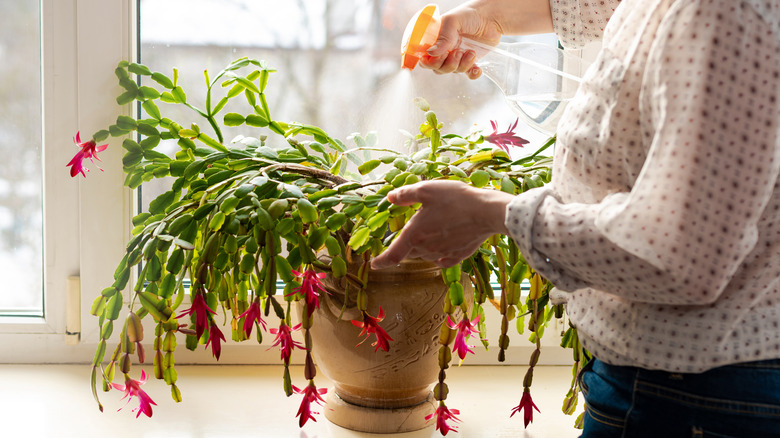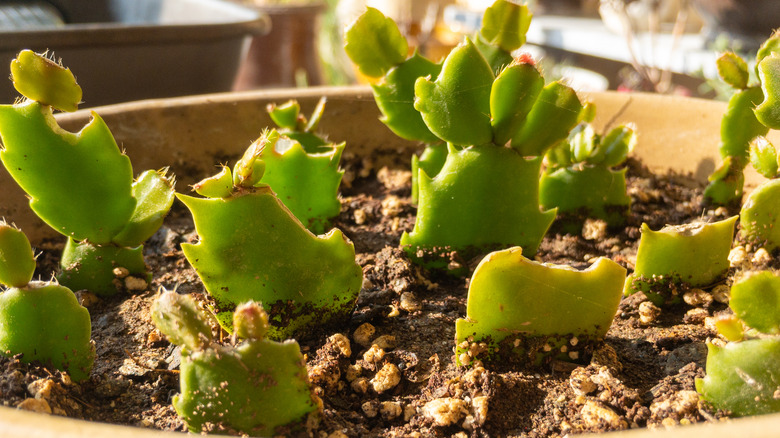Don't Turn A Blind Eye To This Common Christmas Cactus Problem
Not many people think of a tropical succulent when they think "winter holidays," but the Christmas cactus is just that. This dramatically draping plant blooms around the holidays, which is how it gets its name. However, it doesn't necessarily evoke images of snowy houses or roaring fireplaces. Instead, it sports vibrant pink blooms and originates from tropical rainforests, so it loves moisture and humidity. Because of this, plant owners tend to water this plant more often than a typical succulent or cactus — but overwatering it can lead to root rot, a common Christmas cactus problem. If you notice stem rot, you shouldn't turn a blind eye. You need to act fast to save what you can of the plant before it's too late.
Seeing brown spots on the stems indicates that the fungus has spread from the roots to the rest of the plant, so saving it will be rather difficult. However, there are some steps you can take to preserve parts of the Christmas cactus and give it a second chance.
Why stem rot on a Christmas cactus is serious
Stem rot on a Christmas cactus is extremely difficult to reverse. Your most realistic course of action is to clip some of the healthy leaves so you can propagate them, starting a new plant from scratch. If you fail to do so in time, the likely result will be tossing the entire plant into the bin. Once the issue has escalated from root rot to stem rot, most of the plant is likely compromised by fungus.
You will know your plant has stem rot when you notice brown, mushy spots on the stem close to the soil. The fungus will begin to eat away at the stem, killing the healthy tissue and digging deeper into the stalk. These spots can spread, killing more of the plant if you don't catch it in time. While you can technically try to save the plant from rot, it's very difficult and usually has little success. To attempt this, you would need to remove the plant from its pot and cut away any rotted roots. If they're squishy rather than firm, that means the rot has killed them. Then, cut the brown spots from the stems and repot the plant into a clean pot and new, damp soil. You want to avoid watering it for a bit, only doing so when the soil is dry. However, this won't guarantee the plant will bounce back, so propagation is your best bet.
How to propagate your Christmas cactus
The best thing you can do when your plant has stem rot is propagate clippings from your Christmas cactus so you can grow a new plant. Luckily, they're easy to regrow. All you need to do is snip off a clipping from the stem. You don't want it to be too long; instead, two to five succulent segments are plenty. Also, make sure that the clipping comes from a healthy part of the stem. Avoid any segments that are near mushy brown spots to ensure you're not cutting something already infected with fungus. Once you have your clipping, allow it to dry out for a few hours or overnight.
Next, prepare the soil the cutting will root in. It does best in a mix of peat and sand soil. Pop the leaf into the dirt from the cut end, burying it about 1 inch into the dirt. Put it in indirect sunlight, and use restraint when watering it so as not to create another case of root rot. After a couple of weeks, the roots should begin to grow and the leaves to sprout. Once the roots have reached 1 inch in length, transfer the cutting to potting soil, and you can begin to water it with a little more frequency. Before long, you'll have a healthy Christmas cactus.

